Stephen Van Rensselaer
Stephen Van Rensselaer III (/ˈrɛnslər, -slɪər/;[3] November 1, 1764 – January 26, 1839) was a New York landowner, businessman, militia officer, and politician.
Stephen Van Rensselaer | |
|---|---|
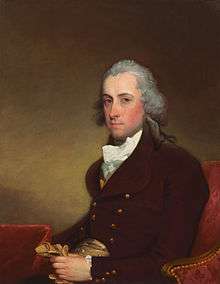 | |
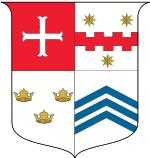 Stephen van Rensselaer III, c. 1790s, by Gilbert Stuart | |
| Member of the U.S. House of Representatives from New York's 10th district | |
| In office March 4, 1823 – March 3, 1829 | |
| Preceded by | John D. Dickinson |
| Succeeded by | Ambrose Spencer |
| Member of the U.S. House of Representatives from New York's 9th district | |
| In office March 12, 1822 – March 3, 1823 | |
| Preceded by | Solomon Van Rensselaer |
| Succeeded by | James L. Hogeboom |
| Lieutenant Governor of New York | |
| In office 1795–1801 | |
| Governor | John Jay |
| Preceded by | Pierre Van Cortlandt |
| Succeeded by | Jeremiah Van Rensselaer |
| Member of the New York State Senate from the Western District, at-large | |
| In office 1791–1796 | |
| Member of the New York State Assembly from the Albany County district, at-large | |
| In office 1789–1791 | |
| Grand Master of the Masonic Grand Lodge of New York | |
| In office 1825–1829 | |
| Preceded by | Joseph Enos |
| Succeeded by | Morgan Lewis |
| 9th Patroon and 6th Lord of the Manor of Rensselaerswyck | |
| In office 1769–1839 | |
| Preceded by | Stephen Van Rensselaer II |
| Succeeded by | Stephen Van Rensselaer IV |
| Personal details | |
| Born | November 1, 1764 New York City, Province of New York, British America |
| Died | January 26, 1839 (aged 74) New York City, New York, U.S. |
| Resting place | Albany Rural Cemetery, Menands, New York |
| Political party | Federalist Adams Republican |
| Spouse(s) | Margarita "Peggy" Schuyler
( m. 1783; died 1801)Cornelia Paterson
( m. 1802) |
| Children | 12, including Stephen, Cortlandt and Henry |
| Relatives | See Van Rensselaer family |
| Alma mater | Harvard College |
| Profession | Landowner Businessman |
| Net worth | USD $3.1 billion at the time of his death (equivalent to $101 billion in 2014)[1][2] |
A graduate of Harvard College, at age 21, Van Rensselaer took control of Rensselaerswyck, his family's manor. He developed the land by encouraging tenants to settle it, and granting them perpetual leases at moderate rates, which enabled the tenants to use more of their capital to make their farms and businesses productive.
Active in politics as a Federalist, Van Rensselaer served in the New York State Assembly and New York State Senate, and as Lieutenant Governor of New York. After the demise of the Federalist Party, Van Rensselaer was a John Quincy Adams supporter, and served in the United States House of Representatives for one partial term and three full ones.
Van Rensselaer was a supporter of higher education; he served on the board of trustees for several schools and colleges, and was the founder of the Rensselaer Polytechnic Institute. He was also a civic activist and philanthropist, and was a founder of Albany's public library and the city's Institute of History & Arts.
Long active in the militia, Van Rensselaer attained the rank of major general; he commanded troops on the New York-Canada border during the War of 1812, but resigned his commission after defeat at the Battle of Queenston Heights.
After Van Rensselaer's 1839 death, efforts by his sons to collect past due lease payments led to the Anti-Rent War, and the break up and sale of the manor. As the heir to and then owner of one of the largest estates in New York, Van Rensselaer's holdings made him the tenth richest American of all time, based on the ratio of his fortune to contemporary GDP.
Early life
Van Rensselaer was born in New York City, the eldest child of Stephen Van Rensselaer II, the ninth patroon of Rensselaerswyck, a large land grant in upstate New York awarded by the Dutch to his ancestor Kiliaen Van Rensselaer. His mother was Catharina Livingston, daughter of Philip Livingston, a signer of the Declaration of Independence. His family was very wealthy, and the Van Rensselaer Manor House was a rich childhood environment for the young boy to grow up in. However, his father died in 1769 when Van Rensselaer was only five.[4]
Van Rensselaer was raised by his mother and stepfather, the Rev. Eilardus Westerlo, whom his mother married in 1775, and his Livingston grandfather.[5] His uncle, Abraham Ten Broeck, administered the Van Rensselaer estate after the untimely death of Van Rensselaer's father. From an early age, Van Rensselaer was raised to succeed his father as lord of the manor.[4] Stephen's younger brother Philip S. Van Rensselaer (1767–1824), later served as Mayor of Albany from 1799 to 1816 and again from 1819 to 1820.
Van Rensselaer began attending the College of New Jersey (later Princeton); since it was near to battles of the ongoing American Revolution, he was later sent to Harvard College, at which he graduated Phi Beta Kappa[6] in 1782.[7]
Early career
On his 21st birthday, Van Rensselaer took possession of Rensselaerswyck, his family's 1,200 square mile (3,072 km²) estate, and began a long tenure as lord of the manor.[8] Van Rensselaer desired to profit from the land, but was extremely reluctant to sell it off.[9] Instead, he developed the land by granting perpetual leases at moderate rates; Van Rensselaer derived a steady rental income from his property, while tenants were able to become successful farmers without having to pay a large purchase price up front.[10] This meant that they could invest more in their operations, which led to increased productivity in the area. Over time, Van Rensselaer became landlord to more than 80,000 tenants.[11] He generally proved to be a lenient landlord; he accepted produce such as grain and firewood in place of cash for rent payments,[12] and when tenants found themselves in financial difficulty, he usually preferred to accept late or partial payments rather than evict them.[13] One facet of the leases Van Rensselaer granted was the "quarter-sale"—tenants who sold their leases were required to pay Van Rensselaer one fourth of the sale price or one additional year's rent.[14] Over time, this requirement became a point of contention between Van Rensselaer and the tenants, which in part led to the Anti-Rent War.[14]
In the First Census of the United States in 1790, it was noted that he owned fifteen slaves.[15] By the time of the 1830 Census, he had none, in keeping with New York's gradual emancipation law, under which all slaves in the state were freed by 1827.[16] Van Rensselaer later became an advocate of enabling African Americans to emigrate to colonies in Africa, such as Liberia, and he served as a vice president of the Albany Auxiliary Society and the American Colonization Society.[17][18]
In 1791, Van Rensselaer was one of the incorporators of the Albany Library, which evolved over time into the Albany Public Library, and he was chosen to serve on the board of trustees.[19] In 1797, Van Rensselaer was an organizer of the Albany and Schenectady Turnpike Company, and served on its board of directors.[20]
Political career
A Federalist, Van Rensselaer was a member of the New York State Assembly from 1789 to 1791, and the New York State Senate from 1791 to 1796.
He was Lieutenant Governor of New York from 1795 to 1801, elected with Governor John Jay. Van Rensselaer, over his time in politics, acquired a reputation as something of a reformer, voting in favor of extending suffrage and going against much of New York's upper class in doing so. In 1801, Van Rensselaer presided over the state constitutional convention,[21] was the Federalist nominee for Governor of New York, and lost to George Clinton, 24,808 votes to 20,843.[22]
He was one of the first to advocate for a canal from the Hudson River to the Great Lakes and was appointed to a commission to investigate the route in 1810,[23] reporting favorably to the Assembly in 1811.[21] Van Rensselaer served on the Erie Canal Commission for 23 years (1816–1839), fourteen of which he served as its president. In 1821, he was a member of the New York State Constitutional Convention.[24]
In 1822, he won the special election for the seat in the House of Representatives from which his cousin Solomon had resigned.[25][26] He served from February 27, 1822 to March 3, 1829, during the Seventeenth, Eighteenth, Nineteenth, and Twentieth Congresses; during the last three sessions, he was the chairman of the Committee on Agriculture.[27][28]
Role in deciding 1824 presidential election
In 1825 Van Rensselaer cast the vote that likely decided the presidential election in favor of John Quincy Adams. Because none of the four candidates received a majority of electoral votes in the 1824 presidential election, the U.S. House had to choose from the top three finishers—Adams, Andrew Jackson, and William H. Crawford. House members voted first individually by state, and then each state cast one ballot for the candidate who received a majority of the state's House delegation; a candidate had to carry 13 state delegations to win the election. Van Rensselaer had intended to vote for Crawford, but changed his mind and voted for Adams. His vote gave Adams a majority of the New York delegation; winning New York gave Adams 13 states in the House vote, to seven for Jackson and four for Crawford.[29]
Military career
In 1786, Van Rensselaer was appointed a major in the Albany County Regiment of the New York Militia.[30] He became commander of the regiment two years later as a lieutenant colonel,[31] and was subsequently promoted to colonel.[31] In 1801 he was promoted to major general as commander of the state militia's cavalry division.[31]
War of 1812
Van Rensselaer's militia experience led to an appointment to command troops during the War of 1812. When war was declared on Great Britain in June 1812, Van Rensselaer was a leading Federalist candidate for Governor of New York. Democratic-Republican Party leaders, including President James Madison and incumbent New York Governor Daniel D. Tompkins devised a way to remove Van Rensselaer from the campaign by offering him command of the Army of the Centre—U.S. militia and regular Army troops massing in upstate New York for an invasion of Canada. If Van Rensselaer declined a military leadership role during a time of war, he would lose esteem in the eyes of the voters. If he accepted, he would likely be unable to run for governor.
Van Rensselaer accepted; despite having held high rank in the militia, he was largely inexperienced at leading large bodies of troops. As a condition of his acceptance, his cousin Solomon, who had more military experience, was appointed his aide-de-camp. But the Army of the Centre consisted largely of untrained, inexperienced militiamen; under the Constitution, which stressed that the role of the militia was to enforce laws, prevent insurrection, and repel invasion, they did not have to cross into Canada to fight.
The British were in the process of fortifying the Queenston Heights that Van Rensselaer would have to attack, and his officers were itching for action despite their general's desire to delay until his troops were better trained and organized. To make matters worse, Brigadier General Alexander Smyth, Van Rensselaer's subordinate, had a large force of regular Army troops that was theoretically under Van Rensselaer's command, but Smyth refused to subordinate himself to a militia officer. With some of his officers planning to try and force him from command, Van Rensselaer decided to act without Smyth.
On October 13, 1812, Van Rensselaer launched an attack on the British position that would evolve into the Battle of Queenston Heights. Though initially successful, Van Rensselaer's inadequate preparations and his plan of attack were clearly main reasons for what became a major defeat. He was unable to secure the element of surprise, he did not procure enough boats for his men to cross the Niagara River easily, and he was even unable to supply his soldiers with sufficient ammunition. Despite significantly outnumbering the British in the early stages of the battle, the American soldiers, untried and untrained, sometimes refused to cross to the Canadian side of the river. Once the tide of the battle turned, Van Rensselaer was not even able to coax the boatmen into going back over to rescue the doomed attack force. His forces were badly beaten by British troops under generals Isaac Brock and, after Brock's death, Roger Hale Sheaffe.
The defeat at Queenston Heights spelled the end to Van Rensselaer's active military career; after the battle he resigned his post. He continued to serve in the militia, and was the senior major general in the state at the time of his death.[32] Despite his military setback, Van Rensselaer was still the Federalist candidate for governor in April 1813; he lost to Tompkins 43,324 votes to 39,713.[22]
Later career

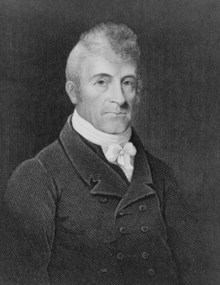
After the war, Van Rensselaer continued his service on the Erie Canal Commission, and between 1820 and 1823 commissioned an agricultural and geological survey of the canal's surroundings, at his own expense.[21] He also held many significant posts after the war. In 1820, he was elected president of the state Board of Agriculture.[33] Also in 1820, he was an incorporator of the Albany Savings Bank, and was elected to serve as the bank's president.[20]
In 1824, Van Rensselaer was one of the organizers of the Albany Institute, and was elected its president. This organization later merged with another to form the Albany Institute of History & Art.[20] He was also active in the American Lyceum organization, and served as its president.[34]
When the New York Life Insurance and Trust Company received its corporate charter from the State of New York in 1830, Van Rensselaer was an original incorporator, and he went on to serve as a member of the company's board of directors.[35] New York Life Insurance and Trust operated until 1922, when it merged with the Bank of New York to become the Bank of New York & Trust Company.[36]
Following the 1834 death in France of the Marquis de Lafayette, Van Rensselaer was appointed marshal for the Albany-area commemorations.[20] He led the parade of militia members, fire fighters, Revolutionary War veterans and others, which culminated in speeches and a eulogy by William Buell Sprague.[20]
Higher education advocate
Van Rensselaer was elected one of the members of the Williams College Corporation in 1794.[20]
In 1812, Van Rensselaer took part in the incorporation of the Lancaster School, an institution dedicated to providing an education for children whose parents could not afford to send them to school, and he served on the school's board of trustees.[37][38] In 1813, Van Rensselaer was one of the organizers of The Albany Academy, and was chosen to serve as the first president of the school's board of trustees.[20]
Van Rensselaer was a member of the University of the State of New York Board of Regents from 1819 to 1839, and from 1835 to 1839 he was the board's chancellor.[39]
In 1824 Van Rensselaer and Amos Eaton established the Rensselaer School (now known as Rensselaer Polytechnic Institute, or RPI) "for the purpose of instructing persons, who may choose to apply themselves, in the application of science to the common purposes of life".[40] Since its founding, RPI has developed a reputation for academic excellence, particularly in the field of engineering.[41]
Religious activities
Van Rensselaer was long active in the Dutch Reformed Church; he served several terms as a deacon and elder of the First Reformed Church in Albany, and attended numerous synod meetings and similar gatherings as a delegate.[42][43] He was active in the American Home Missionary Society, and served as the organization's president in the 1820s.[44] In 1834, he donated a lot at the corner of Green and South Ferry Streets in Albany for construction of the Third Reformed Church.[45] For many years, Van Rensselaer was a member of the Albany Bible Society, and he served on its board of managers.[46] He was also active on the American Board of Commissioners for Foreign Missions, and served as vice president.[47]
Masonic Grand Master
Van Rensselaer was an active Mason beginning early in his adulthood; from 1825 to 1829 he served as the Grand Master of the Grand Lodge of New York.[48] His leadership of the statewide organization coincided with the rise of the Anti-Masonic Party in Western New York, and Van Rensselaer forged an alliance with the Democrats of the Albany Regency led by Martin Van Buren and Enos T. Throop as a way to blunt the political influence of the Anti-Masons.[49]
Personal life
Several members of Van Rensselaer's extended family served in Congress including Jeremiah Van Rensselaer (1741–1810), Killian K. Van Rensselaer (1763–1845), and Solomon Van Rensselaer (1774–1852).[4]
In June 1783, Van Rensselaer married Margarita "Peggy" Schuyler (1758–1801), a distant cousin and the daughter of Revolutionary War general Philip Schuyler,[50] and sister-in-law of Alexander Hamilton. Their marriage resulted in three children, all of whom were baptized at the First Dutch Reformed Church in Albany. Only one of their children survived to adulthood:[51]
- Catherine Schuyler Van Rensselaer (1784–1797), who died young
- Stephen Van Rensselaer (1786–1787), who died young
- Stephen Van Rensselaer IV (1789–1868), inherited the east side of Rensselaerwyck and inherited the manor in 1839 by his father's will. He graduated from Princeton in 1808. He served as major general of militia. During the anti-rent troubles in 1839 he sold his townships, and at his death the manor passed out of the hands of his descendants.[51]
_MET_DP168948_(cropped).jpg)
After Schuyler's death in 1801, he married Cornelia Bell Paterson in 1802,[52] the daughter of William Paterson, the 2nd Governor of New Jersey, and later, an Associate Justice of the Supreme Court of the United States.[53] Together, they had:[51]
- Catherine Van Rensselaer (1803–1874), who married Gouverneur Morris Wilkins (d. 1871)[52]
- William Paterson Van Rensselaer (1805–1872), who married Eliza Bayard Rogers (1811–1835), and after her death, her sister, Sarah Rogers (1810–1887), both were granddaughters of William Bayard Jr.[52]
- Philip Stephen Van Rensselaer (1806–1871), who married Mary Rebecca Tallmadge (1817–1872), daughter of James Tallmadge Jr.[52]
- Cortlandt Van Rensselaer (1808–1860), a noted Presbyterian clergyman.[52]
- Henry Bell Van Rensselaer (1810–1864), a politician and general in the Union Army during the American Civil War, who married Elizabeth Ray King, a granddaughter of Rufus King.[52]
- Cornelia Paterson Van Rensselaer (1812–1890), who married Robert James Turnbull Jr. (1807–1854), son of Robert James Turnbull.[51]
- Alexander Van Rensselaer (1814–1878), who married Mary Howland in 1851. In 1864, he married Louisa Barnewell.[51]
- Euphemia White Van Rensselaer (1816–1888),[52] who married John Church Cruger (1807–1879)[51]
- Westerlo Van Rensselaer (1820–1844), who died aged 24.[52]
Van Rensselaer died in New York City on January 26, 1839. He was buried in a family cemetery at the Van Rensselaer Manor House, and was later reinterred at Albany Rural Cemetery, Section 14, Lot 1.[54]
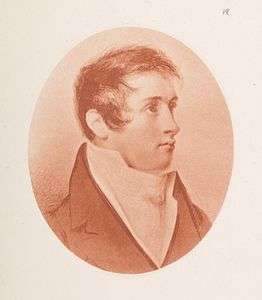 Artotype of Van Rensselaer's son, Stephen, by Edward Bierstadt, 1888
Artotype of Van Rensselaer's son, Stephen, by Edward Bierstadt, 1888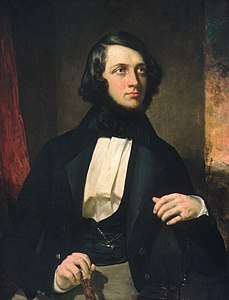 Van Rensselaer's son, Alexander, painted by George P. A. Healy, 1837
Van Rensselaer's son, Alexander, painted by George P. A. Healy, 1837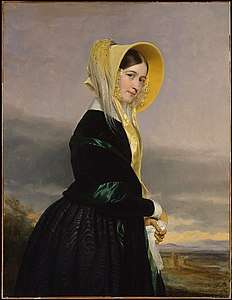 Van Rensselaer's daughter, Euphemia, painted by George P. A. Healy, 1842
Van Rensselaer's daughter, Euphemia, painted by George P. A. Healy, 1842.jpg) Drawing of Van Rensselaer's son, Cortlandt, 1889
Drawing of Van Rensselaer's son, Cortlandt, 1889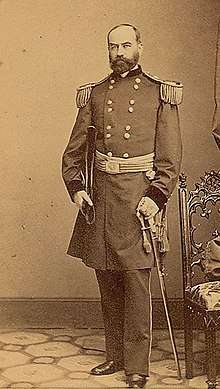 Photograph of Van Rensselaer's son, General Henry Bell
Photograph of Van Rensselaer's son, General Henry Bell
Descendants

His granddaughter, Justine Van Rensselaer (1828–1912), married Dr. Howard Townsend, a noted physician at Albany Medical College.[55] His grandson, Stephen Van Rensselaer Cruger married Julia Grinnell Storrow, a popular American novelist.[56]
His great-grandson was John Eliot Thayer (1862–1933), an amateur ornithologist.[57] His great-granddaughter, Cornelia Van Rensselaer Thayer (1849–1903) married J. Hampden Robb (1846–1911), a New York State Senator, in 1868.[58] Their daughter—Van Rensselaer's 2x great-granddaughter, Cornelia Van Rensselaer Thayer (b. 1881)—married Danish Count Carl Moltke (1869–1935) in 1907.[59]
Through his great-grandson, Stephen Van Rensselaer Crosby (1868–1959),[60][61] he was the 2x great-grandfather of Henry Sturgis Crosby (1898–1929), a bon vivant, poet, and publisher who for some epitomized the Lost Generation in American literature,[62] who was married to Mary Phelps Jacob (1891–1970).[63]
Through his son Henry Bell Van Rensselaer and Henry's granddaughter Julia Floyd Delafield, Stephen Van Rensselaer was the great-great-grandfather of Floyd Crosby (1899–1985) and great-great-great grandfather of David Crosby and Jane Wyatt.[64]
Legacy and honors
The town of Stephentown, New York is named for Stephen Van Rensselaer.[65]
In 1791, Van Rensselaer was elected as an honorary member of the New York Society of the Cincinnati.[66] In 1822, Van Rensselaer received the honorary degree of LL.D. from Yale University.[67] In 1998, the Rensselaer Polytechnic Institute Alumni Hall of Fame inducted Van Rensselaer as a member.[68]
See also
References
- Hargreaves, Steve (June 2, 2014). "The Richest Americans in History: Stephen Van Rensselaer". CNN. Atlanta, GA.
- Keister, Lisa A.; Southgate, Darby E. (2012). Inequality: A Contemporary Approach to Race, Class, and Gender. New York, NY: Cambridge University Press. p. 174. ISBN 978-0-521-86196-0.
- Thomas, Dave (September 28, 2011). "RENSSELAERVILLE (Documentary Film)". Retrieved May 11, 2020.
- Bielinski, Stefan. "Stephen Van Rensselaer III", nysm.nysed.gov; accessed April 15, 2016.
- Fitch, Charles Elliott (1916). Encyclopedia of Biography of New York, Volume 1. New York: American Historical Society. p. 56.
- University), Phi Beta Kappa Massachusetts Alpha (Harvard (1912). Catalogue of the Harvard Chapter of Phi Beta Kappa, Alpha of Massachusetts. Cambridge, Massachusetts: Harvard University. Retrieved 7 September 2016.
- Ricketts, Palmer Chamberlain (1914). History of Rensselaer Polytechnic Institute, 1824-1914. J. Wiley and Sons. Retrieved March 3, 2014.
- Koniowka, Randy S. (2013). Legendary Locals of Cohoes. Charleston, SC: Arcadia Publishing. p. 18. ISBN 978-1-4671-0091-5.
- Jordan, John Woolf (1911). Colonial Families of Philadelphia, Volume 2. New York: Lewis Publishing Company. p. 986.
- Hamilton, Alexander; Harold C., Syrett (1979). The Papers of Alexander Hamilton: May 1, 1802-October 23, 1804. New York: Columbia University Press. p. 467. ISBN 0-231-08925-2.
- Silverman, Stephen M.; Silver, Raphael D. (2015). The Catskills: Its History and How It Changed America. New York, NY: Alfred A. Knopf. p. 137. ISBN 978-0-307-27215-7.
- Spooner, W. W. (January 1, 1907). The Van Rensselaer Family. New York, NY: American Historical Magazine. p. 131.
- Republic: A Monthly Magazine, Devoted to the Dissemination of Political Information, Volumes 1-4. Washington, D.C.: Republic Publishing Company. 1875. p. 185.
- The Van Rensselaer Family.
- Heads of Families at the First Census 1790, Genealogical Publishing Co., Inc. 1976, p. 52
- "Stephen Van Rensselaer in the 1830 United States Federal Census". Ancestry.com. Provo, UT: Ancestry.com. 1830. Retrieved February 11, 2016.
- Annual Report of the American Colonization Society. 6–10. Washington, DC: James C. Dunn. 1825. p. 58.
- President's Report, American Colonization Society. Washington, DC: American Colonization Society. 1840. p. 1.
- Reynolds, Cuyler (1906). Albany Chronicles: A History of the City Arranged Chronologically. Albany, NY: J. B. Lyon. pp. 381, 385, 396, 420, 455, 511.
- Albany Chronicles.
- Chisholm, Hugh, ed. (1911). . Encyclopædia Britannica. 27 (11th ed.). Cambridge University Press. p. 896.
- The Tribune Almanac and Political Register. New York, NY: Horace Greeley. 1841. p. 4.
- Spooner, pp. 129
- Carter, Nathaniel H.; Stone, William L.; Gould, Marcus T. C. (1821). Reports of the Proceedings and Debates of the Convention of 1821. Albany, NY: E. and E. Hosford. p. 27.
- "Member of Congress". The Evening Post. New York, NY. March 4, 1822. p. 2.
- "The Election for Members of Congress". The Evening Post. New York, NY. March 4, 1822. p. 2.
- Biographical Directory of the United States Congress, 1774-2005. Washington, DC: US Government Printing Office. 2005. p. 2084. ISBN 978-0-16-073176-1.
- Shell, Eddie Wayne (2013). Evolution of the Alabama Agroecosystem: Always Keeping Up, but Never Catching Up. Montgomery, AL: New South Books. p. 224. ISBN 978-1-60306-203-9.
- Bassett, John Spencer (2006). The Life of Andrew Jackson. Kessinger Publishing. p. 364. ISBN 9781428650558. Retrieved 9 February 2018.
- New York State Legislature (1902). Documents of the Senate of the State of New York. 9. Albany, NY: J. B. Lyon Company. pp. 115, 145, 300, 514.
- Documents of the Senate of the State of New York.
- Urban, Sylvanus (June 1, 1839). "Obituary, General Van Rensselaer". The Gentleman's Magazine. Vol. 11. London, UK: William Pickering, John Bowyer Nichols and Son. p. 660.
- Van Rensselaer, Stephen (1820). Address of the General Committee of the Board of Agriculture of the State of New York to the County Agricultural Societies. New York, NY: John O. Cole. p. 32.
- Barnard, Henry (March 1, 1864). "The American Lyceum". American Journal of Education. Vol. 14. London, UK: Trubner & Co. p. 539.
- New York State Superintendent of Insurance (1868). Ninth Annual Report. Albany, NY: Charles Van Benthuysen & Sons. pp. 733–735.
- "Merger of New York Life Insurance & Trust Company and the Bank of New York". Trust Companies. Vol. 34 no. 6. New York, NY: Fiduciary Publishers, Inc. June 1, 1922. p. 698.
- New York State Legislature (1812). Laws of the State of New York: Passed at the Twenty-Fifth Session of the Legislature. Albany, NY: Solomon Southwick. p. 83.
- Southwick, Solomon (February 17, 1816). "Lancaster School Society". The Christian Visitant. Vol. 1 no. 36. Albany, NY: H. C. Southwick. p. 298.
- Barnard, Daniel D. (1839). A Discourse on the Life, Services and Character of Stephen Van Rensselaer. Albany, NY: Hoffman & White. p. 66.
- "RPI History". About RPI. Rensselaer Polytechnic Institute. Retrieved June 12, 2016.
- Mullaney, Michael (August 21, 2014). "Rensselaer Ranked 5th on USA Today List of "Top 10 Engineering Colleges in the U.S."" (Press release). Troy, NY: Rensselaer Polytechnic Institute. Office of Media Relations.
- Roberts, Warren (2010). A Place in History: Albany in the Age of Revolution, 1775-1825. Albany, NY: Excelsior Editions. p. 247. ISBN 978-1-4384-3329-5.
- Minutes of General Synod: Directory and Financial Reports. 6–10. New York, NY: Mercein & Post. 1836. p. 469.
- Peters, Absalom (June 1, 1829). "Third Anniversary". The Home Missionary. New York, NY: Alexander Ming, Jr. p. 22.
- Peltz, William Law Learned (1948). Peltz Record: Rev. Philip Peltz, D.D., Reformed Protestant Dutch Church. New York, NY: Historical Publishing Company. p. 236.
- Southwick, Solomon (February 7, 1816). "Albany Bible Society". The Christian Visitant. Vol. 1 no. 38. Albany, NY: H. C. Southwick. p. 298.
- "Missionary Societies". The New Hampshire Register and Farmer's Almanac for 1827. Concord, NH: Jacob B. Moore. 1826. p. 101.
- Proceedings of the Grand Lodge of Free and Accepted Masons of the State of New York. New York, NY: Lent & Graff. 1920. pp. 137–138, 263.
- Clay, Henry; Hopkins, James F. (1984). The Papers of Henry Clay. 8. Lexington, KY: University of Kentucky Press. pp. 294–295. ISBN 978-1-57233-715-2.
- Bielinski, Stefan. "Margarita Schuyler Van Rensselaer". New York State Museum. Archived from the original on 16 February 2016. Retrieved 8 December 2015.
- Sullivan, Robert G. (1911). "Hudson-Mohawk Genealogical and Family Memoirs: Van Rensselaer Vol. IV". www.schenectadyhistory.org. Schenectady County Public Library. pp. 1814–1821. Retrieved 6 December 2016.
- Reynolds, Cuyler (1914). Genealogical and Family History of Southern New York, Volume 3. New York: Lewis Publishing Company. pp. 1166, 1341.
- One or more of the preceding sentences incorporates text from a publication now in the public domain: Cabell, Isa Carrington (1889). . In Wilson, J. G.; Fiske, J. (eds.). Appletons' Cyclopædia of American Biography. New York: D. Appleton.
- "Albany Rural Cemetery Burial Cards, 1791-2011, entry for Stephen Van Rensselaer (1764-1839)". Ancestry.com. Provo, UT: Ancestry.com, LLC. Retrieved September 23, 2017.
- Reynolds, Cuyler (1914). Genealogical and Family History of Southern New York. 3. New York, NY: Lewis Historical Publishing Company. p. 1105.
- "DEATH OF S.V.R. CRUGER.; The Soldier and Man Prominent in Business Affairs Passes Away at the Age of Fifty-four" (PDF). The New York Times. 24 June 1898.
- Spooner, Walter Whipple (1 January 1900). "Van Rensselaer family". American Historical Magazine. S.l. : s.n. (Vol. 2 Issue 1). Retrieved 8 November 2016.
- "J. HAMPDEN ROBB, EX-SENATOR, DEAD; Retired Merchant and Banker Was Once Active in Councils of Democratic Party". The New York Times. January 22, 1911. Retrieved 8 November 2016.
- "Miss Thayer is Countess. Weds Danish Noble at Lancaster. Ceremony at Country Home by Bishop Lawrence. Moltke, Diplomat, is the Bridegroom". New York Times. 30 June 1907. Retrieved 26 March 2011.
This noon, at ... beautiful country seat of Mr and ... National Thayer, their daughter, ... Cornelia Van Rensselaer Thayer ... Count Carl Moltke of Copenhagen, ... were married...
- Times, Special To The New York (4 January 1959). "STEPHEN VAN R. CROSBY". The New York Times. Retrieved 9 November 2016.
- Greenberg, Arnie. "The Glory Years: The Crosbys: Harry and Caresse". Bonjour Paris. Retrieved 26 February 2014.
- Wolff 2003, pp. 12.
- Conover, Anne (1989). Caresse Crosby: From Black Sun to Roccasinibalda. Santa Barbara, California: Capra Press. ISBN 0-595-15928-1.
- "ALIPH WHITEHEAD TO WED F.D. CROSBY; New York Girl's Engagement Is Announced by Her Parents. SHE IS IN JUNIOR LEAGUE Her Fiance Is a Grandson of the Late Dr. and Mrs. Francis C. Delafield". The New York Times. 5 December 1930. Retrieved 31 October 2016.
- Laws of the State of New York. State of New York. 1788. p. 757. Retrieved 2009-08-31.
- Schuyler, John (1886). Institution of the Society of the Cincinnati. New York, NY: Douglas Taylor. p. 96.
- Bulletin of Yale University: President's Report. New Haven, VT: Yale University. June 1, 1909. p. 59.
- "Rensselaer Alumni Hall of Fame". rpi.edu/. Rensselaer Polytechnic Institute. 1998.
Sources

- Turner, Wesley B. (2011). The Astonishing General: The Life and Legacy of Sir Isaac Brock. Dundurn Books, 376 pages.
- Spooner, Walter Whipple (1907). The Van Rensselaer Family. American Historical Magazine.
External links
| Wikimedia Commons has media related to Stephen van Rensselaer III. |
- United States Congress. "Stephen Van Rensselaer (id: V000056)". Biographical Directory of the United States Congress.
- Stephen Van Rensselaer III biography from the New York State Museum
- HISTORY OF THE ALBANY INSTITUTE
- New York history with election result 1813
- Van Rensselaer's explanation to Gen. Dearborn as to why the Americans lost the Battle of Queenston
- Stephen Van Rensselaer at Find a Grave
| Party political offices | ||
|---|---|---|
| Preceded by John Jay |
Federalist nominee for Governor of New York 1801 |
Vacant Title next held by Aaron BurrEndorsed |
| Preceded by Jonas Platt |
Federalist nominee for Governor of New York 1813 |
Succeeded by Rufus King |
| Political offices | ||
| Preceded by |
Member of the New York State Assembly from the Albany County District, at-large 1789–1791 |
Succeeded by |
| Preceded by |
Member of the New York State Senate from the Western District, at-large 1791–1796 |
Succeeded by |
| Preceded by Pierre Van Cortlandt |
Lieutenant Governor of New York 1795–1801 |
Succeeded by Jeremiah Van Rensselaer |
| U.S. House of Representatives | ||
| Preceded by Solomon Van Rensselaer |
Member of the U.S. House of Representatives from New York's 9th congressional district 1822–1823 |
Succeeded by James L. Hogeboom |
| Preceded by John D. Dickinson |
Member of the U.S. House of Representatives from New York's 10th congressional district 1823–1829 |
Succeeded by Ambrose Spencer |
| Academic offices | ||
| Preceded by Simeon De Witt |
Chancellor of the University of the State of New York 1835–1839 |
Succeeded by James King |

